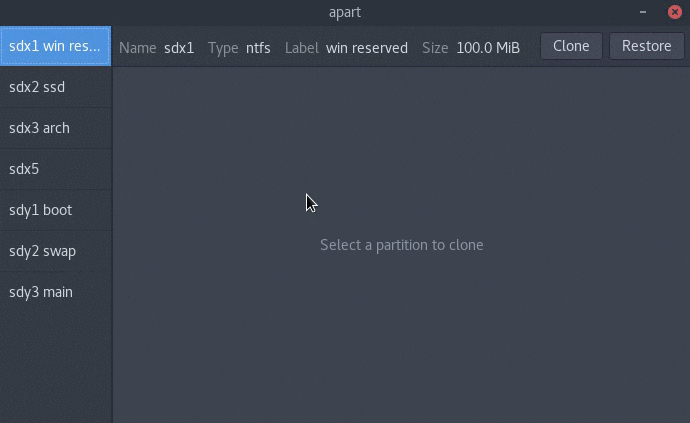Some time ago a tutorial of How to create a "restore point" with Clonezilla he teaches us to create a exact image of our PC which can then be restored. On this occasion, we are going to teach how to clone and restore partitions using a tool called Apart GTK which has been a GUI of partclone, which is very simple to use and very effective.
What is Apart GTK?
It is a GUI for Linux that allows us to clone and restore disk partitions quickly and easily, it uses partclone technology to create a compressed file image that in short is an exact image of the partition that we have chosen.
Apart GTK has been created using Python by Alex Butler, the tool shows us a very simple interface that lists the partitions connected to our computer and gives us the possibility of create a clone of the partition we choose which will be stored in the directory of our preference, in the same way, it offers us the possibility of restoring a clone that we have stored in a partition.
Count with one fairly straightforward copy history which also gives us the possibility to delete or restart the cloning process.
What is partclone?
partclone is a powerful open source utility that allows us to efficiently create hard drive images that can then be easily restored, is available on most popular distros and its usage is terminal based.
Partclone is a tool that has technology that allows you to allows only clone used blocks, which makes the copying process much faster and more efficient. Similarly, its developers have focused on adding technology that allows them to ensure that the images created are compatible with most of the current discs and file formats.
Today Partclone is compatible with the following partition formats:
- Btrfs
- ext2, ext3, ext4
- fat32, fat12, fat16
- ntfs
- exfat
- hfsp
- JFS
- reisfs
- travel4
- ufs (with SU + J)
- vmfs (v3 and v5)
- xfs
- f2fs
- nilfs2
How to install Apart GTK
To install Apart GTK we must meet the following dependencies:
- python> = 3.5
- python-gobject, GTK> = 3.22
- pyzmq, humanize, pyyaml
- polkit - for non-root usage
- zeromq> 4
- partclone
- pigz
Then we can make use of the packages that its developer has prepared for the following distros:
- Arch: Available in the repositories AUR
- Ubuntu / Debian: Available a .deb that we can download from here.
- Fedora: And a . Rpm available in the official releases of the application.
Users of other distros can install Apart GTK from source code, by running the following commands:
$ git clone https://github.com/alexheretic/apart-gtk.git $ cd apart-gtk / $ ./configure $ make $ make install
Learning to clone and restore disk partitions with Apart GTK
In the following gif you can see how easy it is to clone and restore disk partitions using Apart GTK

Basically when running the application it detects all the partitions that we have mounted, and it lists them in a left sidebar, if we click on any of them, the history of copies that we have made will open and it will allow us to make a new copy (with the Clone button) or restore in said partition a copy that we have stored (with the Restore button).
We can make as many compressed images of files we want and they will be stored in the location that we indicate, we can cancel the process of creating a copy or simply delete one made.
Without a doubt, this simple but powerful tool that has been released for more than 4 months, can be useful on many occasions, test it and use it many times before taking it to a production environment where the data is very sensitive.
Thanks for the contribution, how do you restore if you want to change your dd for one of greater capacity?
One way to do it is to make a copy of the original partition (you back it up somewhere external), in the other dd you partition it and in one of the partitions you install a light linux (so it doesn't take up much space), you install aprt gtk in said installation and you restore the copy that you have saved in the partition you want of your new dd ... I hope I have explained myself properly, the other is to install the new dd as a slave and install the copy on it.
Good contribution! One question, does the backup create it by taking the total disk space? That is, the used and unused space. Or you can define that in the settings. Thank you!
According to the article, it only makes the backup of the used space:
"It has technology that allows you to only clone used blocks, which makes the copying process much faster and more efficient."
Greetings,
The best cloning app I've seen is for Mac. It's called Carbon Copy Cloner. It's just as easy to use, and it makes bootable copies.
That is, you create a backup copy of your system on, for example, a pendrive, and it is bootable. Hope they do something similar for Linux
Good afternoon:
I would be interested in the program but I have a problem, is there no 32bits ?.
Thanks in advance and greetings.
Very interesting application much more practical than the old Partimage.
My question is whether it can be used on encrypted partitions.
With DD you can also do the same and you will find a tutorial on this same page and it is not complicated to save on installing applications. https://blog.desdelinux.net/tip-comando-dd-con-barra-de-progreso/
I think that with DD you clone the disk / partition but also with the unused spaces. That is the difference with this app
I use Copy *. * X: / D / S